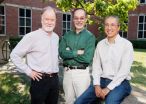(Press-News.org) CHAMPAIGN, Ill. — Scientists call it LUCA, the Last Universal Common Ancestor, but they don't know much about this great-grandparent of all living things. Many believe LUCA was little more than a crude assemblage of molecular parts, a chemical soup out of which evolution gradually constructed more complex forms. Some scientists still debate whether it was even a cell.
New evidence suggests that LUCA was a sophisticated organism after all, with a complex structure recognizable as a cell, researchers report. Their study appears in the journal Biology Direct.
The study builds on several years of research into a once-overlooked feature of microbial cells, a region with a high concentration of polyphosphate, a type of energy currency in cells. Researchers report that this polyphosphate storage site actually represents the first known universal organelle, a structure once thought to be absent from bacteria and their distantly related microbial cousins, the archaea. This organelle, the evidence indicates, is present in the three domains of life: bacteria, archaea and eukaryotes (plants, animals, fungi, algae and everything else).
The existence of an organelle in bacteria goes against the traditional definition of these organisms, said University of Illinois crop sciences professor Manfredo Seufferheld, who led the study.
"It was a dogma of microbiology that organelles weren't present in bacteria," he said. But in 2003 in a paper in the Journal of Biological Chemistry, Seufferheld and colleagues showed that the polyphosphate storage structure in bacteria (they analyzed an agrobacterium) was physically, chemically and functionally the same as an organelle called an acidocalcisome (uh-SID-oh-KAL-sih-zohm) found in many single-celled eukaryotes.
Their findings, the authors wrote, "suggest that acidocalcisomes arose before the prokaryotic (bacterial) and eukaryotic lineages diverged." The new study suggests that the origins of the organelle are even more ancient.
The study tracks the evolutionary history of a protein enzyme (called a vacuolar proton pyrophosphatase, or V-H+PPase) that is common in the acidocalcisomes of eukaryotic and bacterial cells. (Archaea also contain the enzyme and a structure with the same physical and chemical properties as an acidocalcisome, the researchers report.)
By comparing the sequences of the V-H+PPase genes from hundreds of organisms representing the three domains of life, the team constructed a "family tree" that showed how different versions of the enzyme in different organisms were related. That tree was similar in broad detail to the universal tree of life created from an analysis of hundreds of genes. This indicates, the researchers said, that the V-H+PPase enzyme and the acidocalcisome it serves are very ancient, dating back to the LUCA, before the three main branches of the tree of life appeared.
"There are many possible scenarios that could explain this, but the best, the most parsimonious, the most likely would be that you had already the enzyme even before diversification started on Earth," said study co-author Gustavo Caetano-Anollés, a professor of crop sciences and an affiliate of the Institute for Genomic Biology at Illinois. "The protein was there to begin with and was then inherited into all emerging lineages."
"This is the only organelle to our knowledge now that is common to eukaryotes, that is common to bacteria and that is most likely common to archaea," Seufferheld said. "It is the only one that is universal."
The study lends support to a hypothesis that LUCA may have been more complex even than the simplest organisms alive today, said James Whitfield, a professor of entomology at Illinois and a co-author on the study.
"You can't assume that the whole story of life is just building and assembling things," Whitfield said. "Some have argued that the reason that bacteria are so simple is because they have to live in extreme environments and they have to reproduce extremely quickly. So they may actually be reduced versions of what was there originally. According to this view, they've become streamlined genetically and structurally from what they originally were like. We may have underestimated how complex this common ancestor actually was."
INFORMATION:
The study team also included Kyung Mo Kim, of the Korea Research Institute of Bioscience and Biotechnology; and Alejandro Valerio, of the Museum of Biological Diversity in Columbus, Ohio.
The National Institute of Allergy and Infectious Diseases and the National Science Foundation provided funding for this study.
Editor's notes: To reach Manfredo Seufferheld, call 217-333-6505; email seufferh@illinois.edu.
To reach Gustavo Caetano-Anollés, call 217-333-8172; email gca@illinois.edu.
To reach James Whitfield, call 217-333-2567; email jwhitfie@illinois.edu.
The paper, "Evolution of Vacuolar Proton Pyrophosphatase Domains and Volutin Granules: Clues Into the Early Evolutionary Origin of the Acidocalcisomes," is available from the U. of I. News Bureau.
Last universal common ancestor more complex than previously thought
2011-10-06
ELSE PRESS RELEASES FROM THIS DATE:
Scientists determine alternative insecticide dramatically reduces malaria transmission
2011-10-06
(Deerfield, Ill., USA – October 5, 2011) Indoor spraying with the insecticide bendiocarb has dramatically decreased malaria transmission in many parts of Benin, new evidence that insecticides remain a potent weapon for fighting malaria in Africa despite the rapid rise of resistance to an entire class of mosquito-killing compounds, according to a study published today in the October edition of The American Journal of Tropical Medicine and Hygiene.
Scientists with Benin's Entomologic Research Center in Cotonou evaluated the effects of two applications of bendiocarb in ...
New Stanford regimen frees kidney-transplant patients from dependency on immunosuppresant drugs
2011-10-06
STANFORD, Calif. — Investigators at the Stanford University School of Medicine have developed a novel protocol that allows kidney-transplant recipients to jettison their indispensable immune-suppressing drugs. The protocol could also spell substantial savings to the health-care system.
The researchers have reported their progress in a letter that will be published Oct. 6 in the New England Journal of Medicine. Eight of the 12 patients discussed in the small study have now been off of immunosuppressant drugs for at least one year, and in some cases for longer than three ...
Seeds of destruction in Parkinson's disease: Spread of diseased proteins kills neurons
2011-10-06
New research suggests that small "seed" amounts of diseased brain proteins can be taken up by healthy neurons and propagated within them to cause neurodegeneration. The research, published by Cell Press in the October 6 issue of the journal Neuron, sheds light on the mechanisms associated with Parkinson's disease (PD) and provides a model for discovering early intervention therapeutics that can prevent or slow the devastating loss of neurons that underlies PD.
Alpha-synuclein (α-syn) is a brain protein that forms abnormal, neuron-damaging intracellular clumps called ...
Here, there, everywhere: Reward and penalty processing is widespread in the human brain
2011-10-06
Our behavior is often guided by the desire to obtain positive outcomes and avoid negative consequences, and neuroscientists have put a great deal of effort into looking for reward and punishment "centers" in the brain. Now, new research published by Cell Press in the October 6 issue of the journal Neuron reveals that neural signals related to reinforcement and punishment are far more broadly distributed throughout the entire human brain than was previously thought.
Understanding the neural basis of reinforcement and punishment processing is of paramount importance to ...
New mouse model recreates common form of autism
2011-10-06
BOSTON –Over the past decade, new technologies have revealed that autism spectrum disorder has a substantial genetic component. But determining exactly which genes are involved has been like finding the proverbial needle in the haystack.
Now a research team from Beth Israel Deaconess Medical Center (BIDMC) has created a genetically engineered mouse with increased dosages of the Ube3 gene. And, like the patients who also harbor increased dosages of this single gene, the genetically engineered mice exhibit robust examples of all three traits considered hallmarks of autism: ...
Dietary supplements for patients after lung injury do not appear to improve outcomes; may be harmful
2011-10-06
CHICAGO – In contrast to findings of previous studies, patients who experienced an acute lung injury, such as from pneumonia or sepsis, and received dietary supplements including omega-3 fatty acids and antioxidants had more days on a ventilator, more days in the intensive care unit (ICU), and a non-statistically significant increase in the rate of death, according to a study appearing in JAMA. The study is being published early online to coincide with its presentation at the European Society of Intensive Care Medicine meeting in Berlin.
"Patients at risk of developing ...
Oxygenating system associated with lower risk of death for H1N1 patients with respiratory failure
2011-10-06
CHICAGO – Patients with severe 2009 H1N1 influenza who developed respiratory failure and were treated with a system that adds oxygen to the patient's blood had a lower rate of in-hospital death than similar patients who did not receive this treatment, according to a study appearing in JAMA. The study is being published early online to coincide with its presentation at the European Society of Intensive Care Medicine meeting in Berlin.
Extracorporeal membrane oxygenation (ECMO) is a type of life support that circulates blood through a system that adds oxygen. "ECMO may ...
In the brain, winning is everywhere
2011-10-06
Winning may not be the only thing, but the human brain devotes a lot of resources to the outcome of games, a new study by Yale researchers suggest.
The study published in the Oct. 6 issue of the journal Neuron shows that when participants play games, such as rock-paper-scissors, almost the entire brain is engaged, not just the reward centers of the brain, which have been assigned the central role for shaping adaptive human behavior.
"Our brain functions to maximize the chance of survival and reproduction, so reward should be important for all cognitive functions, and ...
Antisense therapy delivers long-term correction of severe spinal muscular atrophy in mice
2011-10-06
Cold Spring Harbor, N.Y. – A new study from Cold Spring Harbor Laboratory (CSHL) reports surprising results that suggest that the devastating neuromuscular disease, spinal muscular atrophy (SMA), might not exclusively affect the motor neurons in the spinal cord as has long been thought. The new findings suggest that defects in peripheral tissues such as liver, muscle, heart, etc., might also contribute to the pathology of the disease in severely affected patients. The study, which also paves the way for a potential SMA drug to enter human trials by the end of the year, ...
Colossal aggregations of giant alien freshwater fish as a potential biogeochemical hotspot
2011-10-06
Many different types of animals come together to form vast groups – insect swarms, mammal herds, or bird flocks, for example. Researchers in France added another example to the list, reported today in the online journal PLoS ONE: the huge Wels catfish, the world's third largest and Europe's largest fresh-water fish. Researchers observed these fish in the Rhone River from May 2009 to Feb. 2011 and found that they formed dense groups of 15 to 44 individuals, corresponding to an estimated total biomass of up to 1132 kilograms with a biomass density of 14 to 40 kilograms per ...

